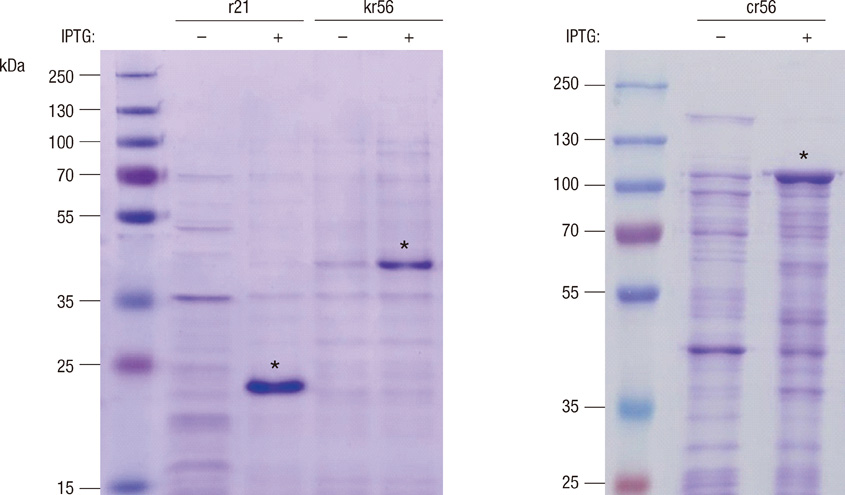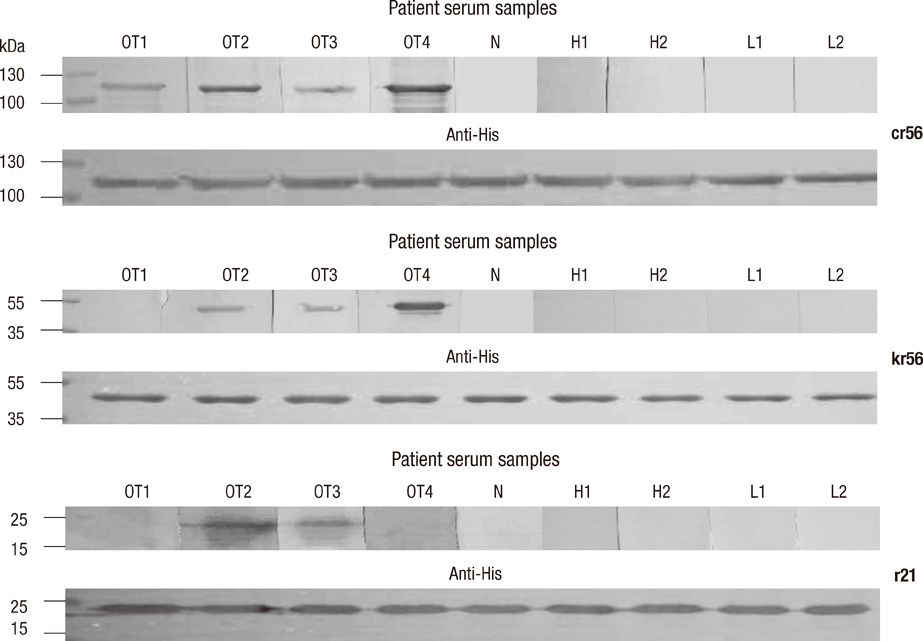J Korean Med Sci.
2013 May;28(5):672-679. 10.3346/jkms.2013.28.5.672.
Improvement of the Diagnostic Sensitivity of Scrub Typhus Using a Mixture of Recombinant Antigens Derived from Orientia tsutsugamushi Serotypes
- Affiliations
-
- 1Immunemed, Chuncheon, Korea. ywkim@hallym.ac.kr
- 2Medical Science Institute, Hallym University, Chuncheon, Korea.
- 3Department of Microbiology, College of Medicine, Hallym University, Chuncheon, Korea.
- 4Department of Life Science, Hallym University, Chuncheon, Korea.
- 5Department of Microbiology, College of Medicine, Korea University, Seoul, Korea.
- 6Division of Pulmonology, Department of Internal Medicine, Medical Center, Hallym University, Chuncheon, Korea.
- 7Department of Microbiology, College of Medicine, Seoul National University, Seoul, Korea.
- KMID: 1777553
- DOI: http://doi.org/10.3346/jkms.2013.28.5.672
Abstract
- Diagnosis of scrub typhus is difficult because its symptoms are very similar to other acute febrile illnesses, such as leptospirosis, murine typhus, and other viral hemorrhagic fevers. To differentiate scrub typhus from other acute febrile diseases, a rapid and reliable serological diagnosis is important. We have developed a chimeric recombinant antigen cr56 and two other recombinant antigens, r21 and kr56, from various serotypes of Orientia tsutsugamushi. They were tested for the detection of antibodies against O. tsutsugamushi in the patient's serum samples using enzyme-linked immunosorbent assay (ELISA) and dot-blot analyses. As of conventional immunofluorescence assay (IFA), when the mixture of these three recombinant antigens was used, both sensitivity and specificity of the recombinant antigens were increased up to 98% in IgM and IgG at ELISA and dot blotting. Additionally, both sensitivity and specificity by detection of IgM and IgG antibodies at rapid diagnostic test (RDT), using the mixture of three antigens and gold conjugated antibodies, were 99%. Our results suggest the use of mixture of these recombinant antigen proteins in ELISA or RDT is suitable as a diagnostic test for scrub typhus.
Keyword
MeSH Terms
-
Antibodies, Bacterial/blood/chemistry/immunology
Antigens, Bacterial/diagnostic use/genetics/metabolism
Enzyme-Linked Immunosorbent Assay
Fluorescent Antibody Technique, Indirect
Gold/chemistry
Humans
Immunoassay
Immunoglobulin G/blood
Immunoglobulin M/blood
Orientia tsutsugamushi/immunology/*metabolism
Recombinant Proteins/biosynthesis/diagnostic use/genetics
Scrub Typhus/*diagnosis
Sensitivity and Specificity
Serotyping
Antibodies, Bacterial
Antigens, Bacterial
Immunoglobulin G
Immunoglobulin M
Recombinant Proteins
Gold
Figure
Reference
-
1. Ohashi N, Tamura A, Suto T. Immunoblotting analysis of anti-rickettsial antibodies produced in patients of Tsutsugamushi disease. Microbiol Immunol. 1988. 32:1085–1092.2. Brown GW, Robinson DM, Huxsoll DL, Ng TS, Lim KJ. Scrub typhus: a common cause of illness in indigenous populations. Trans R Soc Trop Med Hyg. 1976. 70:444–448.3. Chang WH, Kang JS, Lee WK, Choi MS, Lee JH. Serological classification by monoclonal antibodies of Rickettsia tsutsugamushi isolated in Korea. J Clin Microbiol. 1990. 28:685–688.4. Furuya Y, Yamamoto S, Otu M, Yoshida Y, Ohashi N, Murata M, Kawabata N, Tamura A, Kawamura A Jr. Use of monoclonal antibodies against Rickettsia tsutsugamushi Kawasaki for serodiagnosis by enzyme-linked immunosorbent assay. J Clin Microbiol. 1991. 29:340–345.5. Bozeman FM, Elisberg BL. Serological diagnosis of scrub typhus by indirect immunofluorescence. Proc Soc Exp Biol Med. 1963. 112:568–573.6. Elisberg BL, Campbell JM, Bozeman FM. Antigenic diversity of rickettsia tsutsugamushi: epidemiologic and ecologic significance. J Hyg Epidemiol Microbiol Immunol. 1968. 12:18–25.7. Jiang J, Marienau KJ, May LA, Beecham HJ 3rd, Wilkinson R, Ching WM, Richards AL. Laboratory diagnosis of two scrub typhus outbreaks at Camp Fuji, Japan in 2000 and 2001 by enzyme-linked immunosorbent assay, rapid flow assay, and Western blot assay using outer membrane 56-kD recombinant proteins. Am J Trop Med Hyg. 2003. 69:60–66.8. Choi MS, Seong SY, Kang JS, Kim YW, Huh MS, Kim IS. Homotypic and heterotypic antibody responses to a 56-kilodalton protein of Orientia tsutsugamushi. Infect Immun. 1999. 67:6194–6197.9. Kim IS, Seong SY, Woo SG, Choi MS, Kang JS, Chang WH. Rapid diagnosis of scrub typhus by a passive hemagglutination assay using recombinant 56-kilodalton polypeptides. J Clin Microbiol. 1993. 31:2057–2060.10. Kim YW, Min CH, Cho MK, Yoon CS, Cho SI, Choi MK, Kang JS, Chang WH. Murine typhus and scrub typhus in Kangwon-do Korea. Korean J Infect Dis. 1988. 20:105–116.11. Chang WH. Current status of tsutsugamushi disease in Korea. J Korean Med Sci. 1995. 10:227–238.12. Lee JH, Kim YW, Cho MK, Yoon CS, Min CH. Characterization of Rickettsia tsutsugamushi isolated in Korea by immunoblotting. J Korean Soc Microbiol. 1990. 25:237–245.13. Enatsu T, Urakami H, Tamura A. Phylogenetic analysis of Orientia tsutsugamushi strains based on the sequence homologies of 56-kDa type-specific antigen genes. FEMS Microbiol Lett. 1999. 180:163–169.14. Takahashi K, Urakami H, Tamura A. Purification of cell envelopes of Rickettsia tsutsugamushi. Microbiol Immunol. 1985. 29:475–478.15. Kim YW, Kim IS, Chang IA, Woo SD, Kim YJ, Chun JM, Kim WC, Byun YH, Cho MK. Diagnostic formulation for tsutsugamushi disease. Patent #, WO 2008/029981 A1.16. Sambrook J, Russell DW. Molecular Cloning: a laboratory manual. 2001. 3rd ed. Cold Spring Harbor, N.Y.: Cold Spring Harbor Laboratory Press.17. Cho MK, Kim YW, Min CH, Oh HB. Serovar determination of Leptospira interrogans isolated in Korea by cross-agglutinin absorption method (1984-1987). J Korean Soc Microbiol. 1988. 23:169–177.18. Kim IS, Seong SY, Woo SG, Choi MS, Chang WH. High-level expression of a 56-kilodalton protein gene (bor56) of Rickettsia tsutsugamushi Boryong and its application to enzyme-linked immunosorbent assays. J Clin Microbiol. 1993. 31:598–605.19. Ching WM, Wang H, Eamsila C, Kelly DJ, Dasch GA. Expression and refolding of truncated recombinant major outer membrane protein antigen (r56) of Orientia tsutsugamushi and its use in enzyme-linked immunosorbent assays. Clin Diagn Lab Immunol. 1998. 5:519–526.20. Rapmund G. Rickettsial diseases of the Far East: new perspectives. J Infect Dis. 1984. 149:330–338.21. Brown GW, Shirai A, Rogers C, Groves MG. Diagnostic criteria for scrub typhus: probability values for immunofluorescent antibody and Proteus OXK agglutinin titers. Am J Trop Med Hyg. 1983. 32:1101–1107.22. Jang WJ, Huh MS, Park KH, Choi MS, Kim IS. Evaluation of an immunoglobulin M capture enzyme-linked immunosorbent assay for diagnosis of Orientia tsutsugamushi infection. Clin Diagn Lab Immunol. 2003. 10:394–398.23. Ohashi N, Nashimoto H, Ikeda H, Tamura A. Cloning and sequencing of the gene (tsg56) encoding a type-specific antigen from Rickettsia tsutsugamushi. Gene. 1990. 91:119–122.
- Full Text Links
- Actions
-
Cited
- CITED
-
- Close
- Share
- Similar articles
-
- Pulmonary Artery Thrombosis Associated with Scrub Typhus
- Cellular and Systemic Interactions of Orientia tsutsugamushi with Mammalian Host
- A Review of Electrocardiography Changes and Clinical Manifestations in Scrub Typhus in a Single Center
- Identification of Outer Membrane Vesicles Derived from Orientia tsutsugamushi
- Leukocytoclastic Vasculitis Associated with Orientia tsutsugamushi Infection: A Report of Two Cases




